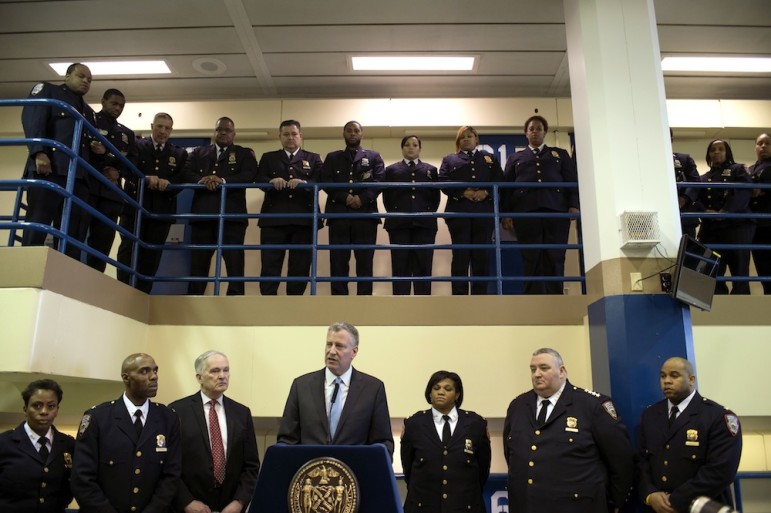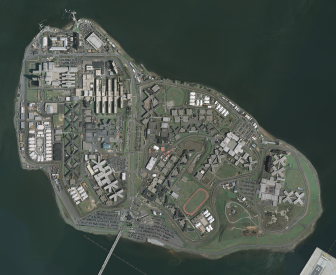
Rob Bennett/Mayoral Photography Office
Mayor Bill de Blasio and Correction Commissioner Joe Ponte announce in March a 14-point plan to aggressively combat violence and promote a culture of safety on Rikers Island.
We are constantly reminded that real change, when it comes to social justice, often comes slowly. The current Broadway hit musical “Hamilton” tries to revitalize the image of a Founding Father who was deeply involved in the 18th-century abolitionist movement, but it took almost another 100 years for emancipation to actually take place.
The long-standing debate over whether Rikers can be reformed to gain a semblance of order, or is beyond hope and should be closed, seems to be coming to a tipping point. The layers of problems and issues the facility faces are like the countless coats of government-issued paint peeling off its crumbling walls: Advocates, civil rights lawyers, and politicians continually chip away with one remedy or another. But will the small victories eventually add up to something New Yorkers can live with?
Glenn Martin of JustLeadershipUSA is one of the more compelling voices in the Rikers Island debate, particularly because, unlike most of the pundits, politicians, lawyers and visionaries involved, he experienced the horror of the place firsthand, having been stabbed there in 1988 while detained on a shoplifting charge. “I spent a year on Rikers 20 years ago, and I have three stab wounds in my body that remind me of Rikers every single day of my life,” Martin says. “What they remind me of is two decades of that kind of human carnage if not more. We forget that although there are (about) 7,600 people there on any given day, that translates into 72,000 admissions per year. That’s a significant amount of harm being caused, particularly when 82 percent of them are (pretrial) detainees, and half of them have bail under $2,000.”
Even before reports on horrors at Rikers began appearing in the press over the last year, Mayor Bill de Blasio’s administration was trying to implement a broad range of reforms to the criminal justice system – although the mayor has admitted he hadn’t thought about the specific need to fix the city’s jails before the ghastly headlines began appearing courtesy of The New York Times and the U.S. attorney.
The administration now seems committed to mending – not ending – Rikers, despite calls for the complex’s closure by voices like John Jay College of Criminal Justice President Jeremy Travis, former Correction Commissioner Martin Horn, and Neil Barsky’s Marshall Project, as well as activists like Martin, the New York City Jails Action Coalition and a social media campaign #ShutDownRikers, which staged a protest outside Rikers on Oct. 23.
In a statement to City Limits, de Blasio spokesperson Monica Klein said, “There have been a number of big, long-term ideas floated to reform the city’s jail system. Right now, Correction Commissioner Joseph Ponte is undertaking dramatic reforms to create a safer and more secure jail each day – including ending punitive segregation for 16- and 17-year-olds, launching a new housing tool to separate the most violent inmates, and tripling the number of security cameras on the island.” Some of the administration’s reforms are part of the settlement of a federal lawsuit over jail conditions.
The administration also stresses new efforts to improve vetting of Department of Correction personnel, as well as special training to deal with the mentally ill and adolescents, two major problem populations at Rikers. In October, Ponte announced he would end solitary confinement, which he referred to as “torture,” for 16- and 17-year-old inmates. Yet solitary, which academic studies insist is a major trigger for self-inflicted violence among inmates, remains an option for everyone 18 and older. Efforts to scale back solitary have been consistently opposed by Correction Officers’ Benevolent Association President Norman Seabrook, who prefers to call it “punitive segregation” and defends it as “the most nonviolent/non-adversarial tool in DOC for enforcing rules and regulations.”
Part of the crisis that plays out on Rikers, however, is actually produced in the city’s courtrooms. One of the island’s major problems is the swelling of its pretrial detainee population due to court backlogs. Kalief Browder’s suicide came after he spent three years at Rikers awaiting trial. In April, de Blasio and the state’s Chief Judge Jonathan Lippman announced “Justice Reboot,” an attempt to tackle the unfortunate reality that more than 1,500 inmates at Rikers have been there for longer than a year because of backlogged courts and inefficient legal representation. One of the features of Justice Reboot is the collection of data to “map specific causes” of delays, with the goal of reducing cases that have been pending for longer than a year.
The Mayor’s Office of Criminal Justice has posted new numbers showing that since Justice Reboot was announced in April, more than 60 percent of criminal court cases involving defendants that had been at Rikers for more than a year have been resolved.
But while some of Justice Reboot’s incremental goals are being attained, the negative headlines continue. A controversy arose this fall over revelations that a chief prosecutor at the Bronx district attorney’s office suspended felony prosecutions of inmates accused of crimes committed while at Rikers in an attempt to clear a backlog of cases. Seabrook immediately objected on the grounds that it was a double standard not to prosecute inmates but still prosecute guards for similar violations. Weeks later Charles Bracey, a Rikers correction officer, was accused of smuggling a small saw blade into the jail.
The jury is still out on whether reforms – such as segregating the most violent inmates in separate wings, increased surveillance to cut down on contraband smuggling, or speeding up the timeline to investigate incidents where force is used – will be effective. An October report issued by city Comptroller Scott Stringer asserted that the rate of fight or assault infractions increased 19 percent in fiscal year 2015, with alleged assaults of staff members by inmates rising 46 percent, and incidents and allegations of the use of force by uniformed employees on inmates jumping by 27 percent.
It’s worth noting that Stringer’s numbers cover a period of time in which the administration’s reforms were still ramping up. Perhaps the most promising of the city’s policy moves are those that aim at reducing the imposition of bail. During her State of the City address in February, City Council Speaker Melissa Mark-Viverito announced a $1.4 million bail fund proposal (modeled on an existing Bronx Freedom Fund that has been in effect for years) that would help “qualified individuals” get bail. De Blasio announced in the spring that the city would no longer impose cash bail in some cases involving minor infractions. And in mid-October de Blasio introduced a “Bail Lab” to experiment with alternatives to cash bail.
But in an illustration of how the politics of the issue can shift, after the slaying of NYPD Officer Randolph Holder last month, de Blasio called for legal changes to broaden the use of bail by allowing judges to consider public safety in their release decisions. And for months, prison-reform advocates have been claiming that the “enhanced supervision housing” reform is a repackaging of solitary confinement, constituting a rollback of that reform goal.
At a recent forum at the Center for New York City Affairs at The New School, the Marshall Project’s Barsky was dismayed with de Blasio’s criticism of Justice Patricia Nuñez for letting Holder’s accused killed go to drug-diversion rehab instead of jail. “I’m not as optimistic about closing Rikers as I was when I wrote the piece this summer,” Barsky said of his New York Times op-ed arguing that closing the facility could be a crucial legacy-builder for the mayor. “Are we one horrible event from backsliding? That’s all it took for the mayor to go to war against a judge who apparently complied with every guideline. … It’s a horrible signal in my opinion for what lies ahead.”
Notably, Barsky was sitting a few chairs over from the empty seat left by Elizabeth Glazer, director of the Mayor’s Office of Criminal Justice, who, according to one of the event’s organizers, canceled at the last minute.
The mayor’s reforms have been a reaction only to the latest Rikers outrages – the treatment of teens and the mentally ill on the island, as exposed by the Times and the U.S. attorney. But Rikers’ history reflects far deeper problems. Suicide numbers spiked in the ’80s and again in the late 1990s. There were riots during the Dinkins years, and though violence fell during the Giuliani administration, concerns about overly aggressive control tactics mounted. In the Bloomberg era, accusations flew about “fight clubs” arranged by correction officers. Medical care on the island has long been the subject of scrutiny. We all know Browder’s name, but what about Christopher Robinson, the teen beaten to death on the island in 2008 for refusing to join a fight club? Or Robert Konopka, the father of two who was awaiting trial in 2001 for verbally harassing a neighbor when correction officers locked him in a cell with Derrick Smart, who’d beaten his grandmother to death with a rubber mallet? Konopka’s autopsy photos showed Smart’s bootprints on his face.
Clearly the wave of Rikers reforms implemented or attempted in recent months are necessary – the “right thing to do,” as City Councilman Daniel Dromm put it. But the big picture remains unchanged, critics say. Rikers is a place – a permanently diseased space – that reinforces an outdated idea of punishment in which relatively minor offenders are housed on the same island as some of the city’s most violent criminals, in crumbling, often unsanitary buildings on land connected to the rest of the city by only a thin span of a bridge.
While the de Blasio administration has taken steps toward reform that may alleviate some of Rikers’ problems, all those steps bank on the idea that Rikers is salvageable. Bandy Lee, a Yale School of Medicine psychologist who worked at Rikers and helped write a Board of Correction report in 2013, says that’s not the case. She says Rikers’ culture is violent to a level she has witnessed “nowhere else” in her work, and that its “organizational chaos” generates violence and brutality.
This affects not only inmates, but the officers who watch them as well, she says.
“The correction officers have a large role in setting the culture because they’re from the same background as the prisoners, same income level, same neighborhoods, and the same education level,” she says. “This creates a recipe for this very violent, brutal culture and contest between correction officers and inmates, inmates versus other inmates, like gladiatorial contests.”
COBA’s Seabrook continues to insist that while the union is in favor of reform, violence against correction officers is increasing, and the current process is deeply flawed because lack of training provided for correction officers and failure to include officers in discussions of use-of-force guidelines. In a November letter to U.S. District Court Judge Laura Taylor Swain, who oversaw the settlement in a brutality lawsuit filed by Rikers inmates through the Legal Aid Society, Seabrook asked for training on use-of-force techniques, as well as the parameters of the concept of “reasonableness” in the use of force against inmates while assessing a threat.
JustLeadershipUSA’s Martin, who says correction officers advised him not to file a complaint about his stab wounds because it would result in a bureaucratic delay, has some compassion for the officers, since his own brother became one.
“I’m not surprised that corrections officers, who arguably spend almost as much time as inmates on Rikers Island, would internalize the fact that they’re in a space that is alienating and figure out ways to survive in that space,” Martin says. “One way they would learn how to survive is to create a culture where they have unquestionable support for each other. The message is sent to them that this is how we handle rehabilitation, this is how we handle correction. And I think they have learned how to live in that space.”
Jailing New York: A Photo Essay












2 thoughts on “Can NYC Reform Rikers Island Without Replacing it?”
The violence at Rikers Island, both directed at inmates and directed at correctional officers, is tragic and deeply concerning. Like many people, I agree that a more humane culture in Rikers Island is sorely needed.
I am concerned about some of the issues raised in general about thinking about whether someone would be a good correctional officer based on socioeconomic, ethnic, gang affiliation or criminal history backgrounds, etc. People need to be evaluated individually to determine their ability to work effectively with people in jail, rather than through a lens of group affiliation.
I don’t think that anyone is really trying to frame this in terms of group affiliation. I believe people are working hard to create some peace and safety by finding explanations for a chaotic situation. However, I think some of the language related to groups can sometimes be misconstrued and this is unhelpful. Clearly, there is nothing inherently violent or non-violent, humane or inhumane about any particular group. Someone with a higher education level can be violent, while someone with a lower education level can be a huge force for compassion and goodness.
Someone with no prior gang affiliation may relate poorly to people in jail, while someone who was previously in a gang may be one of the greatest forces for healing and reconciliation within an institution. Someone with a low socioeconomic status can be a tremendous force for insight and change, etc.
But I agree that bringing in more diversity in terms of correctional staff backgrounds is a great idea. More diversity of backgrounds and perspectives may stir up lots of positive new ways of thinking among everyone.
Clearly there are a whole host of issues at Rikers. Both people who are living there as inmates and people who are correctional staff there have been seriously hurt. This is horrific and awful for both groups. Figuring out how to create a culture of compassion, healing and peace at Rikers Island is going to be challenging, but we need a process that evaluates and sees each person individually. That said, it is inspiring that so much effort is being put into making Rikers a more peaceful place.
Pingback: The Top Criminal Justice Wins of 2017 – In Justice Today